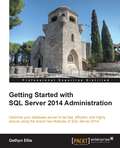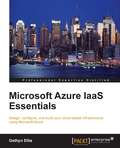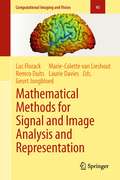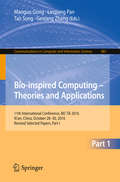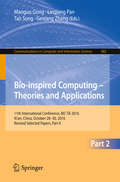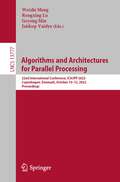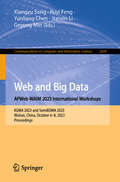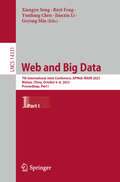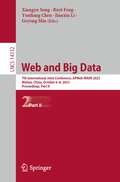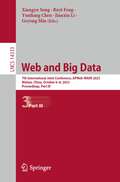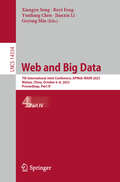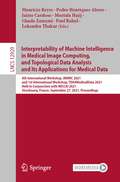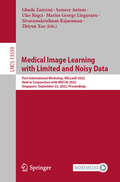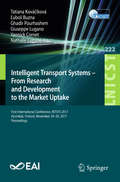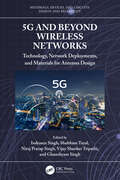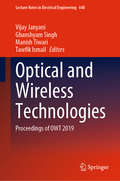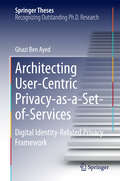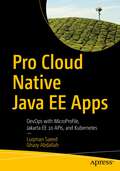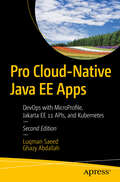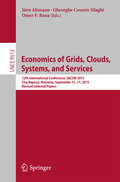- Table View
- List View
Quick Guide UX Management: So verankern Sie Usability und User Experience im Unternehmen (Quick Guide)
by Steffen Weichert Gesine Quint Torsten BartelDieser Quick Guide ist ein praxisnaher Leitfaden, wie der Wandel zu einem nutzerzentrierten Unternehmen gelingt. Die Autoren beginnen mit einer Standort-Bestimmung – mit diesem UX-Reifegrad-Check finden Sie für Ihr Unternehmen den richtigen Strategie-Fokus für UX-Management. Über die Entwicklung der eigenen UX-Vision geht es dann um den Kern von UX-Management: Welche Rahmenbedingungen sind im Unternehmen nötig, damit Produkte und Services mit guter Experience entstehen? Welche Rollen und Kompetenzen braucht es? Wo sollte UX im Unternehmen verortet sein und was bedeutet das für die Zusammenarbeit zwischen den Abteilungen? Und: Wie kann UX-Management dazu beitragen, die Fäden zusammenzuhalten und Silos aufzubrechen?Die 2. Auflage wurde um die Potentialfeld-Analyse erweitert mit der Sie – unabhängig von der UX-Reife Ihres Unternehmens – erkennen können, an welcher UX-Stellschraube Sie in Ihrer Organisation am ehesten drehen sollten, um weitere Optimierungen zu erreichen.Aus dem InhaltBegriffsklärung: User, Usability, User Experience und UX-ManagementUX-Management-Framework: Was gehört dazu, wirklich nutzerzentriert zu sein?UX-Reifegrad-Check: Wie bereit ist meine Organisation für User Experience?Menschen: Welche Rollen spielen Teamzusammensetzung und Kompetenzen?Prozesse: Was wird sich verändern? Kultur: Der Einfluss der Unternehmenskultur auf den gewünschten Wandel.UX-Potentialfeld-Analyse: die Stellschrauben mit dem höchsten Wirkungsgrad
Getting Started with SQL Server 2014 Administration
by Gethyn EllisThis is an easytofollow handson tutorial that includes real world examples of SQL Server 2014's new features. Each chapter is explained in a stepbystep manner which guides you to implement the new technology. If you want to create an highly efficient database server then this book is for you. This book is for database professionals and system administrators who want to use the added features of SQL Server 2014 to create a hybrid environment, which is both highly available and allows you to get the best performance from your databases.
Microsoft Azure IaaS Essentials
by Gethyn EllisThis book is intended for system administrators and other IT professionals who need to both design and implement an Azure-based cloud solution. With the help of this book, you will soon master the basic tasks needed to build a cloud-based solution.
Mathematical Methods for Signal and Image Analysis and Representation
by Luc Florack Marie-Colette van Lieshout Remco Duits Geurt Jongbloed Laurie DaviesMathematical Methods for Signal and Image Analysis and Representation presents the mathematical methodology for generic image analysis tasks. In the context of this book an image may be any m-dimensional empirical signal living on an n-dimensional smooth manifold (typically, but not necessarily, a subset of spacetime). The existing literature on image methodology is rather scattered and often limited to either a deterministic or a statistical point of view. In contrast, this book brings together these seemingly different points of view in order to stress their conceptual relations and formal analogies. Furthermore, it does not focus on specific applications, although some are detailed for the sake of illustration, but on the methodological frameworks on which such applications are built, making it an ideal companion for those seeking a rigorous methodological basis for specific algorithms as well as for those interested in the fundamental methodology per se. Covering many topics at the forefront of current research, including anisotropic diffusion filtering of tensor fields, this book will be of particular interest to graduate and postgraduate students and researchers in the fields of computer vision, medical imaging and visual perception.
Mathematical Methods for Signal and Image Analysis and Representation (Computational Imaging and Vision #41)
by Luc Florack Marie-Colette van Lieshout Remco Duits Geurt Jongbloed Laurie DaviesMathematical Methods for Signal and Image Analysis and Representation presents the mathematical methodology for generic image analysis tasks. In the context of this book an image may be any m-dimensional empirical signal living on an n-dimensional smooth manifold (typically, but not necessarily, a subset of spacetime). The existing literature on image methodology is rather scattered and often limited to either a deterministic or a statistical point of view. In contrast, this book brings together these seemingly different points of view in order to stress their conceptual relations and formal analogies.Furthermore, it does not focus on specific applications, although some are detailed for the sake of illustration, but on the methodological frameworks on which such applications are built, making it an ideal companion for those seeking a rigorous methodological basis for specific algorithms as well as for those interested in the fundamental methodology per se.Covering many topics at the forefront of current research, including anisotropic diffusion filtering of tensor fields, this book will be of particular interest to graduate and postgraduate students and researchers in the fields of computer vision, medical imaging and visual perception.
Bio-inspired Computing – Theories and Applications: 11th International Conference, BIC-TA 2016, Xi'an, China, October 28-30, 2016, Revised Selected Papers, Part I (Communications in Computer and Information Science #681)
by Maoguo Gong Linqiang Pan Tao Song Gexiang ZhangInternational Conference on Bio-Inspired Computing: Theories and Applications (BIC-TA) is one of the flagship conferences on Bio-Computing, bringing together the world's leading scientists from different areas of Natural Computing. Since 2006, the conferences have taken place at Wuhan (2006), Zhengzhou (2007), Adelaide (2008), Beijing (2009), Liverpool & Changsha (2010), Malaysia (2011) and India (2012). Following the successes of previous events, the 8th conference is organized and hosted by Anhui University of Science and Technology in China. This conference aims to provide a high-level international forum that researchers with different backgrounds and who are working in the related areas can use to present their latest results and exchange ideas. Additionally, the growing trend in Emergent Systems has resulted in the inclusion of two other closely related fields in the BIC-TA 2013 event, namely Complex Systems and Computational Neuroscience. These proceedings are intended for researchers in the fields of Membrane Computing, Evolutionary Computing and Genetic Algorithms, DNA and Molecular Computing, Biological Computing, Swarm Intelligence, Autonomy-Oriented Computing, Cellular and Molecular Automata, Complex Systems, etc. Professor Zhixiang Yin is the Dean of the School of Science, Anhui University of Science & Technology, China. Professor Linqiang Pan is the head of the research group of Natural Computing at Huazhong University of Science and Technology, Wuhan, China. Professor Xianwen Fang also works at the Anhui University of Science & Technology.
Bio-inspired Computing – Theories and Applications: 11th International Conference, BIC-TA 2016, Xi'an, China, October 28-30, 2016, Revised Selected Papers, Part II (Communications in Computer and Information Science #682)
by Maoguo Gong Linqiang Pan Tao Song Gexiang ZhangInternational Conference on Bio-Inspired Computing: Theories and Applications (BIC-TA) is one of the flagship conferences on Bio-Computing, bringing together the world's leading scientists from different areas of Natural Computing. Since 2006, the conferences have taken place at Wuhan (2006), Zhengzhou (2007), Adelaide (2008), Beijing (2009), Liverpool & Changsha (2010), Malaysia (2011) and India (2012). Following the successes of previous events, the 8th conference is organized and hosted by Anhui University of Science and Technology in China. This conference aims to provide a high-level international forum that researchers with different backgrounds and who are working in the related areas can use to present their latest results and exchange ideas. Additionally, the growing trend in Emergent Systems has resulted in the inclusion of two other closely related fields in the BIC-TA 2013 event, namely Complex Systems and Computational Neuroscience. These proceedings are intended for researchers in the fields of Membrane Computing, Evolutionary Computing and Genetic Algorithms, DNA and Molecular Computing, Biological Computing, Swarm Intelligence, Autonomy-Oriented Computing, Cellular and Molecular Automata, Complex Systems, etc. Professor Zhixiang Yin is the Dean of the School of Science, Anhui University of Science & Technology, China. Professor Linqiang Pan is the head of the research group of Natural Computing at Huazhong University of Science and Technology, Wuhan, China. Professor Xianwen Fang also works at the Anhui University of Science & Technology.
Algorithms and Architectures for Parallel Processing: 22nd International Conference, ICA3PP 2022, Copenhagen, Denmark, October 10–12, 2022, Proceedings (Lecture Notes in Computer Science #13777)
by Rongxing Lu Jaideep Vaidya Weizhi Meng Geyong MinThis book constitutes the refereed proceedings of the 22nd International Conference on Algorithms and Architectures for Parallel Processing, ICA3PP 2022, which was held in October 2022. Due to COVID-19 pandemic the conference was held virtually. The 33 full papers and 10 short papers, presented were carefully reviewed and selected from 91 submissions. The papers cover many dimensions of parallel algorithms and architectures, encompassing fundamental theoretical approaches, practical experimental projects, and commercial components and systems
Ubiquitous Security: Third International Conference, UbiSec 2023, Exeter, UK, November 1–3, 2023, Revised Selected Papers (Communications in Computer and Information Science #2034)
by Guojun Wang Weizhi Meng Geyong Min Haozhe Wang Nektarios GeorgalasThis book constitutes the proceedings of the Third International Conference, UbiSec 2023, held in Exeter, UK, during November 1–3, 2023.The 29 full papers were carefully reviewed and selected from 91 submissions. They were organized in following topical sections: Cyberspace Security, Cyberspace Privacy, Cyberspace Anonymity
Web and Big Data. APWeb-WAIM 2023 International Workshops: KGMA 2023 and SemiBDMA 2023, Wuhan, China, October 6–8, 2023, Proceedings (Communications in Computer and Information Science #2094)
by Jianxin Li Geyong Min Xiangyu Song Ruyi Feng Yunliang ChenThis proceedings constitutes selected papers from the Workshops KGMA and SemiBDMA which were held in conjunction with APWeb-WAIM 2023 which took place in Wuhan, China, during October 6-8, 2023. The 7 full papers included in this book were carefully reviewed and selected from 15 papers submitted to these workshops. They focus on new research approaches on the theory, design, and implementation of data management systems.
Web and Big Data: 7th International Joint Conference, APWeb-WAIM 2023, Wuhan, China, October 6–8, 2023, Proceedings, Part I (Lecture Notes in Computer Science #14331)
by Jianxin Li Geyong Min Xiangyu Song Ruyi Feng Yunliang ChenThe 4-volume set LNCS 14331, 14332, 14333, and 14334 constitutes the refereed proceedings of the 7th International Joint Conference, APWeb-WAIM 2023, which took place in Wuhan, China, in October 2023. The total of 138 papers included in the proceedings were carefully reviewed and selected from 434 submissions. They focus on innovative ideas, original research findings, case study results, and experienced insights in the areas of the World Wide Web and big data, covering Web technologies, database systems, information management, software engineering, knowledge graph, recommend system and big data.
Web and Big Data: 7th International Joint Conference, APWeb-WAIM 2023, Wuhan, China, October 6–8, 2023, Proceedings, Part II (Lecture Notes in Computer Science #14332)
by Jianxin Li Geyong Min Xiangyu Song Ruyi Feng Yunliang ChenThe 4-volume set LNCS 14331, 14332, 14333, and 14334 constitutes the refereed proceedings of the 7th International Joint Conference, APWeb-WAIM 2023, which took place in Wuhan, China, in October 2023. The total of 138 papers included in the proceedings were carefully reviewed and selected from 434 submissions. They focus on innovative ideas, original research findings, case study results, and experienced insights in the areas of the World Wide Web and big data, covering Web technologies, database systems, information management, software engineering, knowledge graph, recommend system and big data.
Web and Big Data: 7th International Joint Conference, APWeb-WAIM 2023, Wuhan, China, October 6–8, 2023, Proceedings, Part III (Lecture Notes in Computer Science #14333)
by Jianxin Li Geyong Min Xiangyu Song Ruyi Feng Yunliang ChenThe 4-volume set LNCS 14331, 14332, 14333, and 14334 constitutes the refereed proceedings of the 7th International Joint Conference, APWeb-WAIM 2023, which took place in Wuhan, China, in October 2023. The total of 138 papers included in the proceedings were carefully reviewed and selected from 434 submissions. They focus on innovative ideas, original research findings, case study results, and experienced insights in the areas of the World Wide Web and big data, covering Web technologies, database systems, information management, software engineering, knowledge graph, recommend system and big data.
Web and Big Data: 7th International Joint Conference, APWeb-WAIM 2023, Wuhan, China, October 6–8, 2023, Proceedings, Part IV (Lecture Notes in Computer Science #14334)
by Jianxin Li Geyong Min Xiangyu Song Ruyi Feng Yunliang ChenThe 4-volume set LNCS 14331, 14332, 14333, and 14334 constitutes the refereed proceedings of the 7th International Joint Conference, APWeb-WAIM 2023, which took place in Wuhan, China, in October 2023. The total of 138 papers included in the proceedings were carefully reviewed and selected from 434 submissions. They focus on innovative ideas, original research findings, case study results, and experienced insights in the areas of the World Wide Web and big data, covering Web technologies, database systems, information management, software engineering, knowledge graph, recommend system and big data.
Interpretability of Machine Intelligence in Medical Image Computing, and Topological Data Analysis and Its Applications for Medical Data: 4th International Workshop, iMIMIC 2021, and 1st International Workshop, TDA4MedicalData 2021, Held in Conjunction with MICCAI 2021, Strasbourg, France, September 27, 2021, Proceedings (Lecture Notes in Computer Science #12929)
by Jaime Cardoso Mauricio Reyes Pedro Henriques Abreu Mustafa Hajij Ghada Zamzmi Paul Rahul Lokendra ThakurThis book constitutes the refereed joint proceedings of the 4th International Workshop on Interpretability of Machine Intelligence in Medical Image Computing, iMIMIC 2020, and the First International Workshop on Topological Data Analysis and Its Applications for Medical Data, TDA4MedicalData 2021, held on September 27, 2021, in conjunction with the 24th International Conference on Medical Imaging and Computer-Assisted Intervention, MICCAI 2021.The 7 full papers presented at iMIMIC 2021 and 5 full papers held at TDA4MedicalData 2021 were carefully reviewed and selected from 12 submissions each. The iMIMIC papers focus on introducing the challenges and opportunities related to the topic of interpretability of machine learning systems in the context of medical imaging and computer assisted intervention. TDA4MedicalData is focusing on using TDA techniques to enhance the performance, generalizability, efficiency, and explainability of the current methods applied to medical data.
Medical Image Learning with Limited and Noisy Data: First International Workshop, MILLanD 2022, Held in Conjunction with MICCAI 2022, Singapore, September 22, 2022, Proceedings (Lecture Notes in Computer Science #13559)
by Marius George Linguraru Sameer Antani Ghada Zamzmi Ulas Bagci Sivaramakrishnan Rajaraman Zhiyun XueThis book constitutes the proceedings of the First Workshop on Medical Image Learning with Limited and Noisy Data, MILLanD 2022, held in conjunction with MICCAI 2022. The conference was held in Singapore. For this workshop, 22 papers from 54 submissions were accepted for publication. They selected papers focus on the challenges and limitations of current deep learning methods applied to limited and noisy medical data and present new methods for training models using such imperfect data.
Intelligent Transport Systems – From Research and Development to the Market Uptake: First International Conference, INTSYS 2017, Hyvinkää, Finland, November 29-30, 2017, Proceedings (Lecture Notes of the Institute for Computer Sciences, Social Informatics and Telecommunications Engineering #222)
by Giuseppe Lugano Tatiana Kováčiková Ľuboš Buzna Ghadir Pourhashem Yannick Cornet Nathalie LuganoThis book constitutes the proceedings of the First International Conference on Intelligent Transport Systems, INTSYS 2107, which was held in Helsinki, Finland, in November 2017. The 30 revised full papers were selected from 47 submissions and are organized in 6 thematic sessions on planning and sustainable transport and smart cities, intelligent rail transport systems, transport modelling and simulation & big data application, ITS safety and security, cooperative ITS and autonomous driving, and intelligent traffic management.
Understanding Pop-Up Stores through Passion and Practice
by Ghalia BoustaniWhether physical or virtual, heritage brand or start-up, pop-up stores are everywhere: this book provides the ‘why, what, and how’ for entrepreneurs and established brands to capitalize on this exciting format.This book guides readers through the 20-year evolution of pop-up stores, their integration into overarching brand strategies, and the practical ins and outs of pop-up store development, offline or online. Insights from over 90 recent case studies further illuminate the tools that need to be considered and guidelines to be followed for pop-up store success, including distribution, communications strategy, atmospheric design, budgeting, events, and legal considerations.Brand managers, consultants, retail professionals, and retail marketing and management students will benefit from this engaging and reliable guide, learning that behind pop-up stores’ sparkly and ephemeral image lies the utmost attention to detail.
5G and Beyond Wireless Networks: Technology, Network Deployments, and Materials for Antenna Design (Materials, Devices, and Circuits)
by Ghanshyam Singh Shubham Tayal Vijay Shanker Tripathi Indrasen Singh Niraj Pratap Singh5G and Beyond Wireless Networks: Technology, Network Deployments, and Materials for Antenna Design offers a comprehensive overview of 5G and beyond 5G wireless networks along with emerging technologies that support the design and development of wireless networks. It also includes discussions on various materials used for practical antenna design which are suitable for 5G, beyond 5G applications, and cell-free massive MIMO systems.The book discusses the latest techniques used in 5G and beyond 5G (B5G) communication, such as non-orthogonal multiple access (NOMA), device-to-device (D2D) communication, 6G ultra-dense O-RAN, rate-splitting multiple access (RSMA), simultaneous wireless information and power transfer (SWIPT), massive multiple input multiple output (mMIMO), and cell-free massive MIMO systems, which are explained in detail for 5G and beyond cellular networks. The description of NOMA and their benefit for 5G and beyond networks is also addressed along with D2D communication for next generation cellular networks. RSMA technique is also explained for 6G communication. Detailed descriptions for the design and development of 5G and beyond networks over various techniques are included. The materials specification to design antenna for 5G application are also given.The role of metalens in designing effective antennas and material specifications for 5G applications is explained in this book. Apart from the above emerging topics, this book also gives ideas about intelligent communication, Internet of Multimedia Things (IOMT), millimeter-wave MIMO-UFMC, and fog computing cloud networks. The last chapter gives details about the legal frameworks for 5G technology for responsible and sustainable deployment. Overall, this book may benefit network design engineers and researchers working in the area of next generation cellular networks.The contents of this book will be helpful for young researchers and master students, and network design engineers who are working in the area of next generation cellular networks.
Optical and Wireless Technologies: Proceedings of OWT 2019 (Lecture Notes in Electrical Engineering #648)
by Ghanshyam Singh Vijay Janyani Manish Tiwari Tawfik IsmailThis volume presents selected papers from the 3rd International Conference on Optical and Wireless Technologies, conducted from 16th to 17th March, 2019. It focuses on extending the limits of currently used systems encompassing optical and wireless domains, and explores the latest developments in applications like photonics, high speed communication systems and networks, visible light communication, nano-photonics, wireless, and MIMO systems. The proceedings contain high quality scholarly articles, giving insight into the analytical, experimental, and developmental aspects of systems, techniques, and devices in these spheres. This volume will prove useful to researchers and professionals alike.
Alcatel-Lucent Service Routing Architect (SRA) Self-Study Guide
by Glenn Warnock Ghassan Shaheen Mira GhafaryA comprehensive resource for professionals preparing for Alcatel-Lucent Service Routing Architect (SRA) certification Networking professionals are taking note of Alcatel-Lucent and its quick ascent in the networking and telecom industries. IP networking professionals looking for a comprehensive guide to obtaining the Alcatel-Lucent Service Routing Architect (SRA) certification will be pleased to learn of this new publication, Alcatel-Lucent Service Routing Architect (SRA) Self-Study Guide: Preparing for the BGP, VPRN and Multicast Exams. The book comprises approximately 2,600 pages of print and additional online content, making it the foremost resource for those looking to make themselves IP subject matter experts. In this impressive resource, readers will find detailed information to prepare them for various sections of the Service Routing Architect certification, and to familiarize them with topics and learning material for three of the SRA written exams. Pre- and post-chapter assessment questions, sample written exam questions, and valuable lab exercises ensure that readers will gain knowledge and develop strategies for successfully obtaining certification. Other highlights of the book include: Offers a comprehensive look at certification topics through 1,500 pages of printed content and an additional 1,100 pages of authoritative online information Provides strategies for troubleshooting complex network problems Serves as the premier resource for Service Routing Architect certification--similar books do not offer this level of detail Alcatel-Lucent Service Routing Architect (SRA) Self-Study Guide: Preparing for the BGP, VPRN and Multicast Exams has been developed for industry professionals working in network environments where Alcatel-Lucent products are deployed, and for industry professionals with Cisco and Juniper certifications looking to expand their knowledge and skill base. Engineers and networking professionals with an SRA certification from Alcatel-Lucent will be in high demand. Let this must-have learning resource prepare you for success!
Architecting User-Centric Privacy-as-a-Set-of-Services: Digital Identity-Related Privacy Framework (Springer Theses)
by Ghazi Ben AyedHow could privacy play a key role in protecting digital identities? How could we merge privacy law, policies, regulations and technologies to protect our digital identities in the context of connected devices and distributed systems? In this book, the author addresses major issues of identity protection and proposes a service-oriented layered framework to achieve interoperability of privacy and secure distributed systems. The framework is intended to distill privacy-related digital identity requirements (business interoperability) into a set of services, which in turn can be implemented on the basis of open standards (technical interoperability). The adoption of the proposed framework in security projects and initiatives would decrease complexities and foster understanding and collaborations between business and technical stakeholders. This work is a step toward implementing the author's vision of delivering cyber security as a set of autonomous multi-platform hosted services that should be available upon user request and on a pay-per-use basis.
Pro Cloud Native Java EE Apps: DevOps with MicroProfile, Jakarta EE 10 APIs, and Kubernetes
by Luqman Saeed Ghazy AbdallahThis professional guide to Java-based cloud native apps DevOps dives deeper into building and deploying production ready cloud native apps using the increasingly popular open source Eclipse MicroProfile framework, Jakarta EE 10 APIs and the most popular Kubernetes container orchestration tool.After a quick overview of Jakarta EE and MicroProfile, Pro Cloud Native Java EE Apps starts you on your way by walking you through a cloud-native Jakarta EE-based application case study that will be forged piece-by-piece over the course of the book. Next, you'll interject dependencies and data persistence capabilities as microservices to go with the case study app that you are building. Next, you'll employ the REST API using Jakarta REST APIs and the MicroProfile RESTClient. You'll also explore ways to add resilience to your app, keep count with metrics, check on your app's health, secure your app, and test and complete your production-ready cloud-native app. Finally, you'll dive into migrating a monolith to become a production ready cloud-native app. After reading this book, you'll be able to build your own production ready cloud-native Java app using Jakarta EE and MicroProfile. What You Will LearnBuild and deploy a production-ready cloud-native Java app using MicroProfile, Jakarta EE and KubernetesMigrate a monolith app to become a cloud-native appEmploy Jakarta EE APIs such as Persistence, CDI and moreLeverage the MicroProfile frameworkExplore configurations, resilience, metrics, health, security, and more for your cloud-native appsWho This Book Is ForThose software developers and programmers with at least some prior experience using Jakarta EE, MicroProfile. At least some prrior Java experience is expected.
Pro Cloud-Native Java EE Apps: DevOps with MicroProfile, Jakarta EE 11 APIs, and Kubernetes
by Luqman Saeed Ghazy AbdallahLearn how to build and deploy Java-based cloud native apps with Jakarta EE with the MicroProfile framework and Kubernetes. This revamped Second Edition reflects the latest updates in Jakarta EE 11, including enhanced support for creating web APIs with Jakarta REST, concurrency management with Jakarta Concurrency, and data persistence with Jakarta Persistence, while incorporating key changes introduced by MicroProfile 7.0. After a quick overview of Jakarta EE and MicroProfile, Pro Cloud Native Java EE Apps starts you on your way by walking you through a cloud-native Jakarta EE-based application case study that will be forged piece-by-piece over the course of the book. Next, you'll interject dependencies and data persistence capabilities as microservices to go with the case study app that you are building. Then, you will dive into migrating a monolith to become a production-ready cloud-native app. Finally, you will look ahead to the future of Jakarta EE with a NEW chapter on artificial intelligence and large language models, exploring potential use cases for how AI-integration can enhance Jakarta EE capabilities. This revised new edition ensures you are equipped with the most current tools and techniques to develop forward-looking, cloud-native apps. What You Will Learn ● Build and deploy a production-ready cloud-native Java app using MicroProfile, Jakarta EE and Kubernetes ● Migrate a monolith app to become a cloud-native app ● Employ Jakarta EE APIs such as Persistence, CDI and more ●<span style="font: 7.0pt '
Economics of Grids, Clouds, Systems, and Services
by Jörn Altmann Omer F. Rana Gheorghe Cosmin SilaghiThis book constitutes the refereed proceedings of the 12th International Conference on Economics of Grids, Clouds, Systems, and Services, GECON 2015, held in Cluj-Napoca, Romania, in September 2015. The 11 revised full papers and 10 paper-in-progress presented were carefully reviewed and selected from 38 submissions. The presentation sessions that have been set up are: resource allocation, service selection in clouds, energy conservation and smart grids, applications: tools and protocols, community networks and legal and socio-economic aspects.

